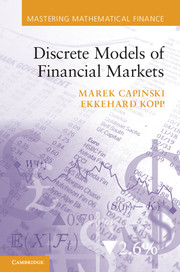3 - Multi-step binomial model
Published online by Cambridge University Press: 05 June 2012
Summary
Having described single-step pricing models rather fully, we are ready to consider models with a finite number of consecutive trading dates. We shall see that these models behave essentially as a succession of one-step models, so that our earlier analysis can be applied repeatedly to yield explicit pricing formulae.
For a simple binomial model we now describe how the use of risk-neutral probabilities implies the martingale property of discounted stock prices and thus of the discounted value process of any self-financing strategy. In this model pricing techniques for European options using replicating portfolios or risk-neutral probabilities are compared and an explicit pricing formula for the European call is then derived.
Two-step example
Most of the essential features of a general multi-step model can be seen in a simple example with two time steps, where we avoid cumbersome notation related to a general case. Here we take time to be 0, T, 2T, and we simplify the notation by just specifying the number of a step, ignoring its length. We wish to build a model of stock prices with three ingredients S(0), S(1), S(2), where S(0) is a given number and the remaining quantities are random variables. The construction consists of two repetitions of the single-step dynamics. In the single-step case the core of the construction was the model of the rate of return with two possible values, which can be thought of as related to a single toss of a coin.
- Type
- Chapter
- Information
- Discrete Models of Financial Markets , pp. 48 - 71Publisher: Cambridge University PressPrint publication year: 2012



